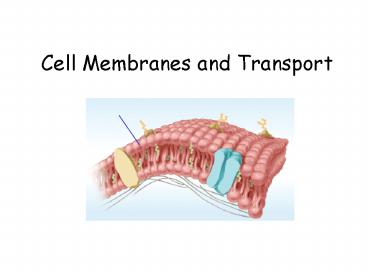Cell Membranes and Transport - PowerPoint PPT Presentation
1 / 29
Title:
Cell Membranes and Transport
Description:
Cell Membranes and Transport What is going on in this picture? Phospholipids Phospholipids Fatty acid chains A phosphate group Glycerol backbone. – PowerPoint PPT presentation
Number of Views:354
Avg rating:3.0/5.0
Title: Cell Membranes and Transport
1
Cell Membranes and Transport
2
What is going on in this picture?
3
Phospholipids
4
Phospholipids
- Fatty acid chains
- A phosphate group
- Glycerol backbone.
- Polar heads
- Nonpolar fatty acids
5
The Fluid Mosaic Model
6
Fluid Mosaic Model
- Transports
- Small molecules
- Between the phospholipids
- Large molecules?!
7
Composition of the Plasma Membrane
- Lipid bilayer
- Peripheral proteins
- Integral proteins
- Cholesterol
- Glycoproteins
- Alpha helix protein
8
Homeostasis
- Maintaining a Balance
- Nutrients
- Water
- Wastes
- Selectively permeable
9
Diffusion
Cell membrane
Outside cell
Inside cell
10
Diffusion
Cell membrane
diffusion
Outside cell
Inside cell
11
Diffusion
Cell membrane
Outside cell
Inside cell
EQUILIBRIUM
12
Facilitated Diffusion
Cell membrane
diffusion
Protein channel
Outside cell
Inside cell
13
Facilitated Diffusion
Cell membrane
diffusion
Protein channel
Outside cell
Inside cell
EQUILIBRIUM
14
Osmosis
CONCENTRATED SOLUTION
DILUTE SOLUTION
Cell membrane partially permeable.
Sugar molecule
VERY Low conc. of water molecules. High water
potential.
VERY High conc. of water molecules. High water
potential.
Outside cell
Inside cell
15
Osmosis
Cell membrane partially permeable.
Low conc. of water molecules. High water
potential.
OSMOSIS
High conc. of water molecules. High water
potential.
Outside cell
Inside cell
16
Osmosis
Cell membrane partially permeable.
OSMOSIS
Outside cell
Inside cell
EQUILIBRIUM. Equal water concentration on each
side. Equal water potential has been reached.
There is no net movement of water
17
Cellular Transport - Passive
- No energy is needed to move particles
- Types of passive transport
- Diffusion
- Facilitated diffusion
- Osmosis
18
What determines the rate of diffusion?
- Steepness of the concentration gradient
- Temperature
- Surface area
- Type of molecule or ion diffusing
19
Whats the Point?
20
Cell Concentrations
- Hypertonic solutions
- More dissolved solute, less water
- Hypotonic solutions
- Less dissolved solute, more water
- Isotonic solutions
- Equal amounts of dissolved solute and water
21
Cell Concentrations Isotonic
- If the outside solution is isotonic to the inside
of the cell - The inside of the cell has the same amount of
dissolved solute as outside the cell - So the water moves
- IN and OUT at equal rates!
22
Cell Concentrations Hypotonic
- If the outside solution is hypotonic to the
inside of the cell - The outside of the cell has less solute and more
water than the inside of the cell - So the water moves
- INTO the cell until equilibrium is reached.
23
Cell Concentrations Hypertonic
- If the outside solution is hypertonic to the
inside of the cell - The outside of the cell has more solute and less
water than the inside of the cell - So the water moves
- OUT of the cell until equilibrium is reached.
24
Overcoming Osmosis
- Contractile vacuoles
- Turgor pressure
25
Cellular Transport - Active
- Active transport
- Energy is needed to move particles UP the
concentration gradient
26
(No Transcript)
27
(No Transcript)
28
Cellular Transport - Active
- Carrier proteins
- Endocytosis
- Pinocytosis
- Phagocytosis
- Exocytosis
29
How Molecules Cross the Membrane































